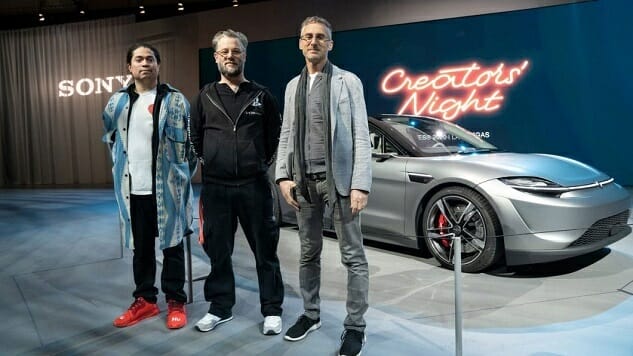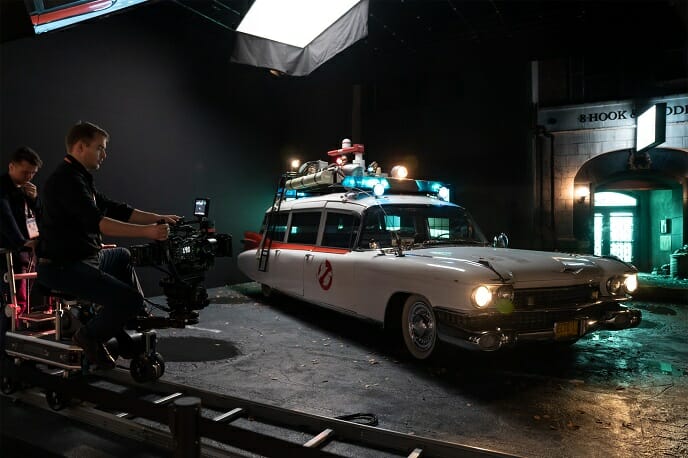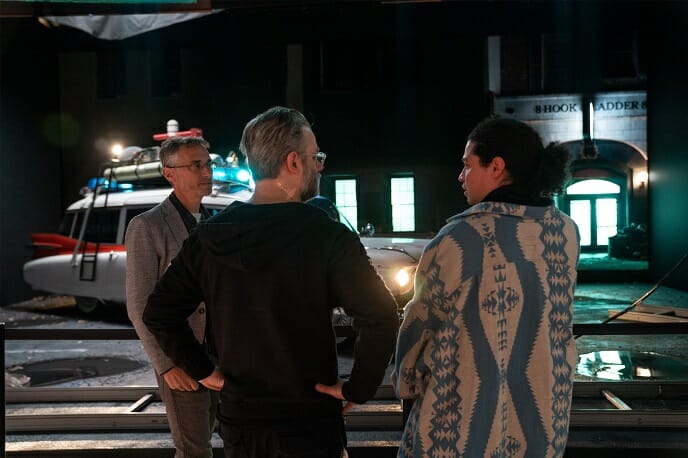Sony Shows How Technology Helps Creativity at CES 2020 with Its Virtual Film Set
Photos courtesy of Sony. L to R: Mike Larson, Cory Barlog, Glenn Gainor.
When Masaru Ibuka and Akio Morita started an electronics company in Tokyo in 1946, they probably didn’t envision that it would become one of the largest corporations on the planet. Originally known as Tokyo Tsushin Kogyo, the company that specialized in tape recorders and radios eventually renamed itself Sony in the ‘50s, because it was easier for Western consumers to pronounce. Sony grew exponentially due to the transistor radio, becoming one of the best-known companies in all of consumer electronics throughout the ‘60s and ‘70s. In the ‘80s it spread into media, buying record companies and movie studios, and in the ‘90s dove into gaming with the PlayStation. By the 2000s Ibuka and Morita’s small concern had expanded its reach into almost all aspects of entertainment, creating both the media that we enjoy and the devices that let us consume it.
As an omnipresent force in the world of consumer electronics, it only makes sense that Sony has an outsized presence at the annual Consumer Electronics Show. This year the company made its wide-ranging diversification the focus of its CES presentation, launching a new “Boundless by Sony” campaign that highlights how Sony technology has impacted—and united—different corners of the media world. This included a panel discussion between three top creatives from the realms of music, gaming and movies: Mike Larson, the sound engineer for Sony Music’s Pharrell Williams; Cory Barlog, the game designer responsible for the most recent God of War game from Sony Interactive Entertainment’s Santa Monica Studio; and Glenn Gainor, the head of physical production at Screen Gems and the president of Sony’s Innovation Studios, which develops new technology for film production.
Selecting these three specific people accentuated almost all of Sony’s various interests, from TVs, to audio equipment, to videogames, film production and beyond. The panel itself didn’t include any groundbreaking revelations—it was just a pleasant chat about the creative process between three high-level creatives whose different disciplines share a few common elements. What it was, though, was an illuminating adjunct to Sony’s CES booth, which focused heavily on 8K televisions, 360 audio headsets and soundbars, and a virtual film set built in part through volumetric data capture. We had already seen these technologies in action, responding to them as consumers; Larson, Barlog and Gainor provided insight from the creators who actually use and design for this technology.
As the head of Innovation Studios, Gainor was able to discuss perhaps the most impressive tech demo on Sony’s show floor, and one that might most succinctly sum up the image Sony hopes to impart through the Boundless campaign. The virtual film set installed at CES included a full-sized Ecto-1 ambulance from Ghostbusters. It sat parked within the three walls of the film set, a crucial practical effect against the lifelike projection backdrop of the Ghostbusters headquarters.

Here’s how the Innovation Studios’ virtual film set works. Imagine a studio that’s essentially a black box. There’s room between its walls for actors, practical sets, the crew and their equipment. Instead of a fully-built out physical set, though, projections of pre-filmed images create a space that looks realistic on camera. The Sony booth ran a constant demo of the tech, with a camera slowly gliding on a rail around the Ecto-1, as the façade of the Ghostbusters building was projected on the walls around it. The feed was streamed to TVs above the set, which showed how seamless and realistic the process looked. Leaves blew over puddles of water on the asphalt in the pre-filmed background, and on the TV screen it looked like it all occupied the same physical space as the car that sat within the set. It even accounts for the angle of the camera and how the lighting and appearance of the projected backdrops should change in relation to it; guests at the Sony booth could see the background image shift as the camera slowly moved, mimicking how the view of a physical building would change alongside the camera’s movements.
-

-

-

-

-

-

-

-

-

-

-

-

-

-

-

-

-

-

-

-

-

-

-

-

-

-

-

-

-

-

-

-

-

-

-

-

-

-

-

-









































